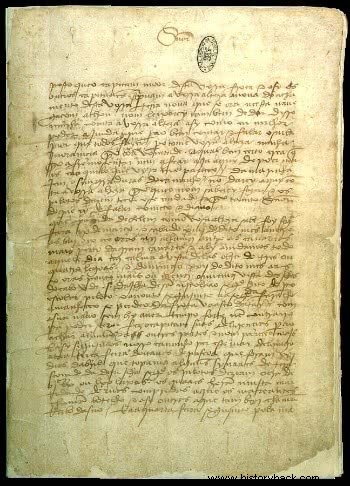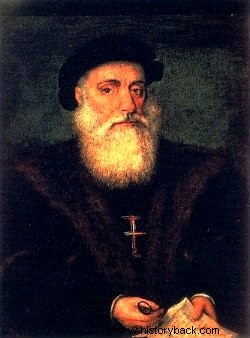The “Letter of Pero Vaz de Caminha ” or “Letter to King Dom Manoel on the discovery of Brazil ” was a document written by Portuguese scribe Pero Vaz de Caminha.
Written on May 1, 1500, in Porto Seguro, Bahia, it was taken to Lisbon under the care of Gaspar de Lemos, considered one of the greatest navigators of his time.
Despite having been written in the 16th century, the Charter was discovered many years later, in the 18th century by José de Seabra da Silva (1732-1813). He was a statesman, minister and head guard of Torre do Tombo.
Its official and academic appearance is the work of the Spanish philosopher and historian Juan Bautista Munoz (1745-1799).
In Brazil, its first publication was in 1817, in the work “Corografia Brasilica ”.
Probably the first version edited in Brazil was by Father Manuel Aires de Casal (1754-1821). He was a Portuguese geographer, historian and priest who lived most of his life in Brazilian territory.
It is important to note that the Walk Letter is considered the first document written in Brazil and, for this reason, it is the literary landmark of the country. It is part of the first literary manifestation belonging to the Quinhentism movement.
Letter Summary

Letter Composition
Initiated as a customary epistolary process, the Letter, after developing the first paragraphs, performing all reverence to the monarch D. Manuel I (1469-1521), will continue as a common diary.
About its composition, it was written on seven sheets, each divided into four pages. From the phonetic connotation of spelling marks, it is worth mentioning that Caminha reproduces the typical period style of Portuguese texts until the 15th century.
Its periodization makes the manuscript an organized and very chronologically ordered product.
The scribe punctuates his text in such a way as to provoke an expressive effect capable of holding the reader's attention. In addition to ensuring that reading the manuscript is quite simple.
Content of the Letter
About its contents, it was a letter written to the king, in order to communicate to him the discovery of the new lands.
The fascination of Europeans in relation to the discovery of the "New World" is very evident in the records made by Caminha. In the Letter he describes his impressions of the territory that would come to be called Brazil.
It documents the physical makeup at first glance of the territory. It also narrates the episode of the Portuguese landing on the beach, the first meeting between the Indians and the colonizers, and the first mass held in Brazil.
Curiosity
The term “discovery” is currently much opposed by Brazilian scholars. This is because it leaves aside the indigenous peoples who inhabited the territory at the time of the arrival of the “discoverers”.
Excerpts from the Letter
Check out the entire work by downloading the PDF here:A Letter by Pero Vaz de Caminha.
Who was Pero Vaz de Caminha?

Pero Vaz de Caminha was born in the city of Porto (Portugal) in 1450 and died in the city of Calicut (India) on December 15, 1500.
His father was the Duke of Bragança and therefore he had a solid education. He worked as treasurer and clerk at the Casa da Moeda. Furthermore, he held the position of councilor of the city of Porto in Portugal.
In 1500, Caminha accompanied Pedro Álvares Cabral's fleet to Brazil, being responsible for writing about the impressions of the land seen. Without a doubt, this was Caminha's greatest achievement and one that immortalized him.
Falled into Enem!
(Enem-2013) From end to end, it's all palm beach, very flat and very beautiful. From the backlands it seemed to us, seen from the sea, very large, because, stretching our eyes, we could only see land with trees, which seemed very long. In it, until now, we have not been able to know that there is gold, or silver, or anything of metal or iron; we didn't even see him. But the earth itself is of very good air [...]. But the best fruit that can be drawn from it, it seems to me, will be to save these people .
Letter from Pero Vaz de Caminha. In:MARQUES, A.; BERUTTI, F.; FARIA, R. Modern history through texts. São Paulo:Context, 2001.
Pero Vaz de Caminha's letter allows us to understand the colonizing project for the new land. In this excerpt, the report emphasizes the following objective:
a) To value the catechesis to be carried out on native peoples.
b) Describe the local culture to enhance Portuguese prosperity.
c) Transmit indigenous knowledge about the existing economic potential.
d) Highlight the poverty of native inhabitants to demarcate European superiority.
e) Criticize the way of life of indigenous peoples to demonstrate the absence of work.
Alternative a) To value the catechesis to be carried out on native peoples.
Read Also :
- Fifteenth century
- Characteristics of the Sixteenth Century
- Information Literature
- Discovery of Brazil
- Arrival of the Portuguese in Brazil
- Exercises on Sixteenth Century
